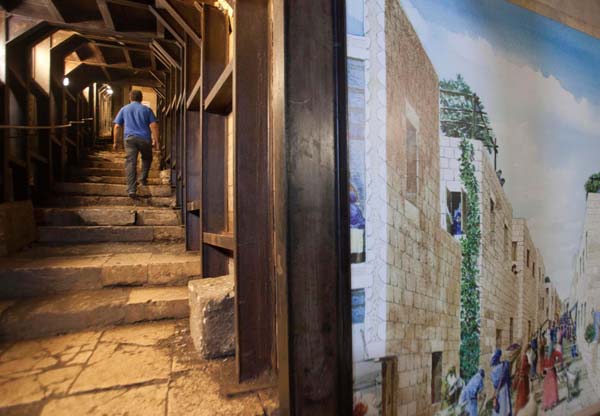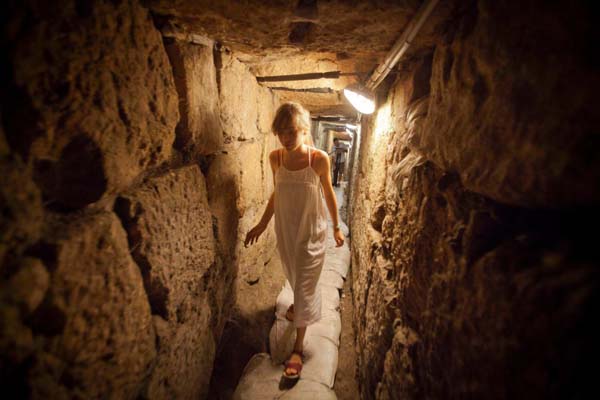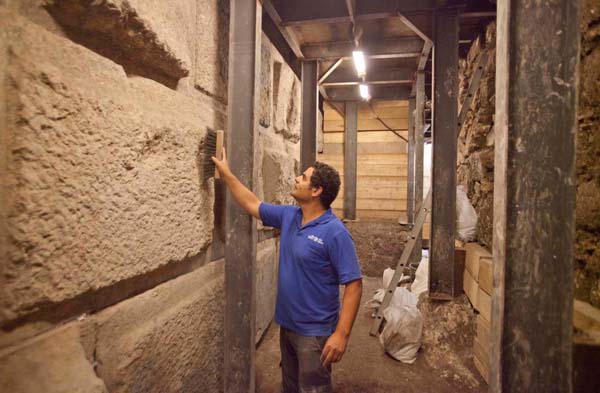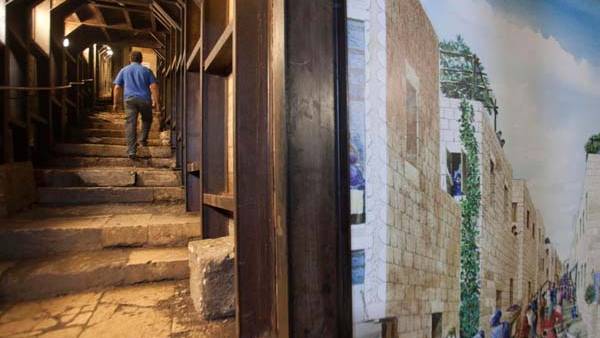In a Jerusalem tunnel, a glimpse of an ancient war
Source: google.com
The excavation of an ancient drainage tunnel beneath Jerusalem has yielded a sword, oil lamps, pots and coins abandoned during a war here 2,000 years ago, archaeologists said Monday, suggesting the finds were debris from a pivotal episode in the city’s history when rebels hid from Roman soldiers crushing a Jewish revolt.The tunnel was built two millennia ago underneath one of Roman-era Jerusalem’s main streets, which today largely lies under an Arab neighborhood in the city’s eastern sector. After a four-year excavation, the tunnel is part of a growing network of subterranean passages under the politically combustible modern city.

In this picture taken Tuesday, Aug. 2, 2011 Eli Shukron, an Israel Antiquities Authority archaeologist walks through what archaeologists say is a 2,000-year-old drainage tunnel leading to Jerusalem’s Old City. The excavation of an ancient drainage tunnel beneath Jerusalem has yielded new artifacts from a war here 2,000 years ago, archaeologists said Monday, Aug. 8, 2011, shedding light on a key episode of the past buried under today’s politically combustible city. (AP Photo/Dan Balilty)

A tourist walks through an underground tunnel. (AP Photo/Dan Balilty)
The tunnel was intended to drain rainwater, but is also thought to have been used as a hiding place for the rebels during the time of the Second Temple in Jerusalem. That temple was razed, along with much of the city, by Roman legionnaires putting down the Jewish uprising in 70 A.D.
On Monday, archaeologists from the Israel Antiquities Authority unveiled a sword found in the tunnel late last month, measuring 24 inches (60 centimeters) in length and with its leather sheath intact. The sword likely belonged to a member of the Roman garrison around the time of the revolt, the archaeologists said.
"We found many things that we assume are linked to the rebels who hid out here, like oil lamps, cooking pots, objects that people used and took with them, perhaps, as a souvenir in the hope that they would be going back," said Eli Shukron, the Israel Antiquities Authority archaeologist in charge of the dig.

Eli Shukron, an Israel Antiquities Authority archaeologist cleans stones making part of an underground section of the Western Wall. (AP Photo/Dan Balilty)
The archaeologists also found a bronze key from the same era, coins minted by rebels with the slogan "Freedom of Zion," and a crude carved depiction of a menorah, a seven-branched Jewish candelabra that was one of the central features of the Temple.
The flight of the rebels to tunnels like the one currently being excavated was described by the historian Josephus Flavius, a Jewish rebel general who shifted his allegiance to Rome during the revolt and penned the most important history of the uprising.
As the city burned, he wrote about five years afterward, the rebels decided their "last hope" lay in the tunnels. They planned to wait until the legions had departed and then emerge and escape.
"But this proved to be an idle dream, for they were not destined to escape from either God or the Romans," he wrote. The legionnaires tore up the paving stones above the drainage channels and exposed their hiding place.
"There too were found the bodies of more than two thousand, some slain by their own hands, some by another’s; but most of them died by starvation," Josephus wrote. The victors proceeded to loot, he wrote, "for many precious objects were found in these passages."
The new tunnel, lit by fluorescent bulbs and smelling of damp earth, has been cleared for much of its length but has not yet been opened to the public. Earlier this month, a team from The Associated Press walked through the tunnel from the biblical Pool of Siloam, one of the city’s original water sources, continuing for 600 yards (meters) under the Palestinian neighborhood named for the pool — Silwan — before climbing out onto a sunlit Roman-era street inside Jerusalem’s Old City.
The tunnel is part of the expanding City of David excavation in Silwan, which sits above the oldest section of Jerusalem. The dig is named for the biblical monarch thought to have ruled from the site. It is funded by a group affiliated with the Jewish settlement movement and has drawn criticism from Palestinian residents who have charged that the work is disruptive and politically motivated.
Israel and the Palestinians have conflicting claims over Jerusalem that have scuttled peace efforts for decades. Both sides claim the Old City, which includes sites holy to Christians, Muslims and Jews.
The excavation of the tunnel began in 2007. Last month, a worker found a tiny golden bell that seemed to have been an ornament on the clothing of a rich man, or possibly a Temple priest, and which could still ring 2,000 years later.
When the tunnel opens to the public sometime in the coming months, underground passages totaling about a mile (1.6 kilometers) in length will be accessible beneath Jerusalem. The tunnels have become one of the city’s biggest tourist draws and the number of visitors has risen in recent years to more than a million in 2010.
The tunnels remain, however, a sensitive political issue. While for Israelis they are proof of the extent of Jewish roots here, for many Palestinians, who reject Israel’s sovereignty in the east Jerusalem, they are a threat to their own claims to the city and represent an exaggerated focus on Jewish history.
The 1996 opening of a new exit to a tunnel underneath the Old City’s Muslim Quarter sparked rumors among Palestinians that Israel meant to damage the mosque compound, and dozens were killed in the ensuing riots. In recent years, however, criticism has been muted and work has largely gone ahead without incident.
Article from: google.com
Also tune into:
Adrian Salbuchi - Zionism & Multiculturalism
Gilad Atzmon - Zionism & Multiculturalism
Israel Shamir - Zionism & Multiculturalism
Wayne Herschel - The Jordanian Codices
Joseph Davidovits - The Construction of the Pyramids & Reconstituted Limestone
Richard Sauder - Underground Bases and Tunnels






















